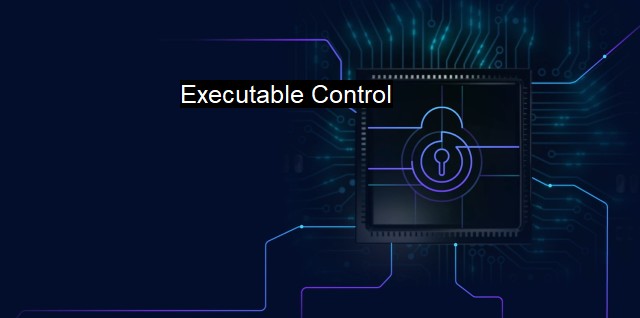What is Executable Control?
The Evolving Challenge of Technology Threats: Executable Control in Cybersecurity
Executable control is a critical aspect of cybersecurity that pertains to managing and regulating the execution of various programs, applications, and services in an information technology (IT) environment. The main concept revolves around choosing which programs are permissible to run on a particular system or network, therefore keeping potentially harmful or unnecessary process sequences at bay.An executable, in technical parlance, refers to a file that can perform a designated function or operation because it contains software or code instructions that a computer's hardware will subsequently institute. Examples of these include applications, system applications, scripts, and batch files. Unfortunately, the inherently functional nature of these files makes them prime targets for exploitation by cybercriminals, thereby warranting careful executable control.
Cybersecurity threats frequently exploit executable files to cause harm. For instance, a common type of cyberattack involves repackaging malicious code within a normally safe executable. When an unsuspecting user initiates this, the execution concurrently triggers the enclosed harmful snippet, leading to various adverse aftermaths, such as data theft, processing disruptions, or an all-out system failure.
Viruses, worms, ransomware, and Trojans are examples of malicious programs often cloaked in executable formats that appear legitimate. Regulating executables therefore strengthens a system's resilience against these potential threats. Maintaining uncompromised cybersecurity necessitates continuing evolutions in executable control measures, given the relentless advancements in attack vectors mastered by cyber felons.
Broadly, executable control techniques operate by either white-listing or black-listing. White-listing is a proactive approach that explicitly defines what is allowed on the system, i.e., the system will only execute files or applications listed, thereby denying any 'alien' program the chance to run. On the contrary, black-listing initially allows all programs to run unless listed as a threat, making it a more passive-protective stance, albeit with the risk of harmful entities slipping through.
Effective executable control forms an essential element of Antivirus solutions. These are software tools specifically designed to spot and nullify malicious programs. They do this by continuously monitoring for suspicious behavior, scanning files against known virus signatures, isolating and eradicating identified threats, and updating their virus databases.
Antivirus solutions employ dynamic executable control models for added protection. they may use 'sandboxing', where an application runs within a safe environment detached from the core system resources, as an extra precautionary step. If the antivirus software detects something malignant during sandbox testing, it blocks the application from the main system, nullifying any potential threat. Antivirus applications may also use 'heuristics', algorithms dedicated to detecting new or altered versions of known viruses.
Executable control in the framework of cybersecurity is all about securing systems by monitoring and controlling what runs on them. It forms a fundamental part of most antivirus software and significantly reduces the risk of system compromise through harmful executables. It continues growing alongside cyber threat methods, making it crucial for institutions to commit to regularly updating their antivirus systems and maintaining vigilant executable control practices. As cybersecurity increasingly influences personal and organizational data safety, prioritizing executable control will remain central to all IT governance strategies.

Executable Control FAQs
What is executable control in cybersecurity?
Executable control is a security measure that prevents unauthorized or malicious code from executing on a computer system. This technique is commonly used by antivirus software to detect and block malware that may attempt to execute on a user's computer.How does executable control work?
Executable control works by analyzing the behavior of executable files and determining whether they are authorized to run on a system. It may use methods such as signature-based detection, which compares the file to a database of known malware, or heuristic analysis, which looks for suspicious behavior. Once an unauthorized or malicious file is detected, the executable control mechanism will prevent it from executing on the system.What are the benefits of executable control?
Executable control provides several benefits to computer security. It helps to prevent malware infections, which can result in theft of personal data, financial loss, or system damage. It can also help to reduce the risk of zero-day attacks, which are attacks that exploit previously unknown vulnerabilities. Additionally, executable control can help to enforce security policies and prevent users from running unauthorized software.Are there any drawbacks to executable control?
One potential drawback of executable control is that it may generate false positives, which are detections of legitimate software as malware. This can be frustrating for users who are unable to run software that they need for their work or personal use. Another potential issue is that executable control may not be able to detect certain types of malware, such as fileless malware that resides only in memory. However, despite these challenges, executable control remains an important tool in the fight against cyber threats.| | A | | | B | | | C | | | D | | | E | | | F | | | G | | | H | | | I | | | J | | | K | | | L | | | M | |
| | N | | | O | | | P | | | Q | | | R | | | S | | | T | | | U | | | V | | | W | | | X | | | Y | | | Z | |
| | 1 | | | 2 | | | 3 | | | 4 | | | 7 | | | 8 | | |||||||